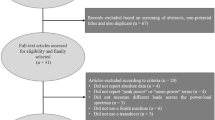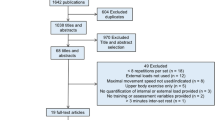Abstract
Background
The development of muscular power is often a key focus of sports performance enhancement programs.
Objective
The purpose of this meta-analysis was to examine the effect of load on peak power during the squat, jump squat, power clean, and hang power clean, thus integrating the findings of various studies to provide the strength and conditioning professional with more reliable evidence upon which to base their program design.
Methods
A search of electronic databases [MEDLINE (SPORTDiscus), PubMed, Google Scholar, and Web of Science] was conducted to identify all publications up to 30 June 2014. Hedges’ g (95 % confidence interval) was estimated using a weighted random-effect model. A total of 27 studies with 468 subjects and 5766 effect sizes met the inclusion criterion and were included in the statistical analyses. Load in each study was labeled as one of three intensity zones: Zone 1 represented an average intensity ranging from 0 to 30 % of one repetition maximum (1RM); Zone 2 between 30 and 70 % of 1RM; and Zone 3 ≥70 % of 1RM.
Results
These results showed different optimal loads for each exercise examined. Moderate loads (from >30 to <70 % of 1RM) appear to provide the optimal load for power production in the squat exercise. Lighter loads (≤30 % of 1RM) showed the highest peak power production in the jump squat. Heavier loads (≥70 % of 1RM) resulted in greater peak power production in the power clean and hang power clean.
Conclusion
Our meta-analysis of results from the published literature provides evidence for exercise-specific optimal loads for power production.






Similar content being viewed by others
References
Cronin JB, Hansen KT. Strength and power predictors of sports speed. J Strength Cond Res. 2005;19(2):349–57.
Loturco I, Artioli GG, Kobal R, et al. Predicting punching acceleration from selected strength and power variables in elite karate athletes: a multiple regression analysis. J Strength Cond Res. 2014;28(7):1826–32.
Wilson GJ, Newton RU, Murphy AJ, et al. The optimal training load for the development of dynamic athletic performance. Med Sci Sports Exerc. 1993;25(11):1279–86.
Hoffman JR, Ratamess NA, Cooper JJ, et al. Comparison of loaded and unloaded jump squat training on strength/power performance in college football players. J Strength Cond Res. 2005;19(4):810–5.
McBride JM, Triplett-McBride T, Davie A, et al. The effect of heavy- vs. light-load jump squats on the development of strength, power, and speed. J Strength Cond Res. 2002;16(1):75–82.
Toji H, Kaneko M. Effect of multiple-load training on the force–velocity relationship. J Strength Cond Res. 2004;18(4):792–5.
Cormie P, McCaulley GO, McBride JM. Power versus strength–power jump squat training: influence on the load–power relationship. Med Sci Sports Exerc. 2007;39(6):996–1003.
Cormie P, McCaulley GO, Triplett NT, et al. Optimal loading for maximal power output during lower-body resistance exercises. Med Sci Sports Exerc. 2007;39(2):340–9.
Izquierdo M, Hakkinen K, Gonzalez-Badillo JJ, et al. Effects of long-term training specificity on maximal strength and power of the upper and lower extremities in athletes from different sports. Eur J Appl Physiol. 2002;87(3):264–71.
Dugan EL, Doyle TL, Humphries B, et al. Determining the optimal load for jump squats: a review of methods and calculations. J Strength Cond Res. 2004;18(3):668–74.
McBride JM, Haines TL, Kirby TJ. Effect of loading on peak power of the bar, body, and system during power cleans, squats, and jump squats. J Sports Sci. 2011;29(11):1215–21.
Alcaraz PE, Romero-Arenas S, Vila H, et al. Power–load curve in trained sprinters. J Strength Cond Res. 2011;25(11):3045–50.
Winchester JB, Erickson TM, Blaak JB, et al. Changes in bar-path kinematics and kinetics after power-clean training. J Strength Cond Res. 2005;19(1):177–83.
Comfort P, Fletcher C, McMahon JJ. Determination of optimal loading during the power clean, in collegiate athletes. J Strength Cond Res. 2012;26(11):2970–4.
Nuzzo JL, Cormie P, McBride JM. Advances in strength and conditioning research. In: Duncan M, Lyons M, editors. Power in resistance exercise. New York: Nova Science Publishers Inc.; 2009. p. 123–45.
Kawamori N, Haff GG. The optimal training load for the development of muscular power. J Strength Cond Res. 2004;18(3):675–84.
Cronin J, Sleivert G. Challenges in understanding the influence of maximal power training on improving athletic performance. Sports Med. 2005;35(3):213–34.
Kilduff LP, Bevan H, Owen N, et al. Optimal loading for peak power output during the hang power clean in professional rugby players. Int J Sports Physiol Perform. 2007;2(3):260–9.
Turner AP, Unholz CN, Potts N, et al. Peak power, force, and velocity during jump squats in professional rugby players. J Strength Cond Res. 2012;26(6):1594–600.
Rhea MR. Synthesizing strength and conditioning research: the meta-analysis. J Strength Cond Res. 2004;18(4):921–3.
Harman EA, Rosenstein MT, Frykman PN, et al. The effects of arms and countermovement on vertical jumping. Med Sci Sports Exerc. 1990;22(6):825–33.
Hori N, Newton RU, Andrews WA, et al. Does performance of hang power clean differentiate performance of jumping, sprinting, and changing of direction? J Strength Cond Res. 2008;22(2):412–8.
Harris NK, Cronin J, Taylor K-L, et al. Understanding position transducer technology for strength and conditioning practitioners. Strength Cond J. 2010;34:66–79.
Egger M, Davey Smith G, Schneider M, et al. Bias in meta-analysis detected by a simple, graphical test. BMJ. 1997;315(7109):629–34.
Higgins JP, Thompson SG, Deeks JJ, et al. Measuring inconsistency in meta-analyses. BMJ. 2003;327(7414):557–60.
Bax L, Yu LM, Ikeda N, et al. Development and validation of MIX: comprehensive free software for meta-analysis of causal research data. BMC Med Res Methodol. 2006;6:50.
Cormie P, McBride JM, McCaulley GO. Validation of power measurement techniques in dynamic lower body resistance exercises. J Appl Biomech. 2007;23(2):103–18.
McBride JM, Skinner JW, Schafer PC, et al. Comparison of kinetic variables and muscle activity during a squat vs. a box squat. J Strength Cond Res. 2010;24(12):3195–9.
Caia J, Doyle TL, Benson AC. A cross-sectional lower-body power profile of elite and subelite Australian football players. J Strength Cond Res. 2013;27(10):2836–41.
Cormie P, McBride JM, McCaulley GO. Power–time, force–time, and velocity–time curve analysis during the jump squat: impact of load. J Appl Biomech. 2008;24(2):112–20.
Cormie P, McBride JM, McCaulley GO. The influence of body mass on calculation of power during lower-body resistance exercises. J Strength Cond Res. 2007;21(4):1042–9.
Crewther BT, McGuigan MR, Gill ND. The ratio and allometric scaling of speed, power, and strength in elite male rugby union players. J Strength Cond Res. 2011;25(7):1968–75.
Dayne AM, McBride JM, Nuzzo JL, et al. Power output in the jump squat in adolescent male athletes. J Strength Cond Res. 2011;25(3):585–9.
Hansen KT, Cronin JB, Pickering SL, et al. Does cluster loading enhance lower body power development in preseason preparation of elite rugby union players? J Strength Cond Res. 2011;25(8):2118–26.
Comfort P, Udall R, Jones PA. The effect of loading on kinematic and kinetic variables during the mid-thigh clean pull. J Strength Cond Res. 2012;26(5):1208–14.
Jones K, Bishop P, Hunter G, et al. The effects of varying resistance-training loads on intermediate- and high-velocity-specific adaptations. J Strength Cond Res. 2001;15(3):349–56.
McBride JM, Triplett-McBride T, Davie A, et al. A comparison of strength and power characteristics between power lifters, olympic lifters, and sprinters. J Strength Cond Res. 1999;13(1):58–66.
McBride JM, Kirby TJ, Haines TL, et al. Relationship between relative net vertical impulse and jump height in jump squats performed to various squat depths and with various loads. Int J Sports Physiol Perform. 2010;5(4):484–96.
Nuzzo JL, McBride JM. The effect of loading and unloading on muscle activity during the jump squat. J Strength Cond Res. 2013;27(7):1758–64.
Swinton PA, Stewart AD, Lloyd R, et al. Effect of load positioning on the kinematics and kinetics of weighted vertical jumps. J Strength Cond Res. 2012;26(4):906–13.
Nibali ML, Chapman DW, Robergs RA, et al. Influence of rest interval duration on muscular power production in the lower-body power profile. J Strength Cond Res. 2013;27(10):2723–9.
Cormie P, Deane R, McBride JM. Methodological concerns for determining power output in the jump squat. J Strength Cond Res. 2007;21(2):424–30.
Kawamori N, Crum AJ, Blumert PA, et al. Influence of different relative intensities on power output during the hang power clean: identification of the optimal load. J Strength Cond Res. 2005;19(3):698–708.
Suchomel TJ, Beckham GK, Wright GA. The impact of load on lower body performance variables during the hang power clean. Sports Biomech. 2014;13(1):87–95.
Suchomel TJ, Wright GA, Kernozek TW, et al. Kinetic comparison of the power development between power clean variations. J Strength Cond Res. 2014;28(2):350–60.
Duchateau J, Hainaut K. Electrical and mechanical failures during sustained and intermittent contractions in humans. J Appl Physiol (1985). 1985;58(3):942–7.
Van Cutsem M, Duchateau J, Hainaut K. Changes in single motor unit behaviour contribute to the increase in contraction speed after dynamic training in humans. J Physiol. 1998;513(Pt 1):295–305.
de Oliveira FB, Rizatto GF, Denadai BS. Are early and late rate of force development differently influenced by fast-velocity resistance training? Clin Physiol Funct Imaging. 2013;33(4):282–7.
Haff GG, Whitley A, Potteiger JA. A brief review: explosive exercises and sports performance. Strength Cond J. 2001;23(3):13–20.
Schoenfeld BJ. Squatting kinematics and kinetics and their application to exercise performance. J Strength Cond Res. 2010;24(12):3497–506.
Rhea MR, Kenn JG, Dermody BM. Alterations in speed of squat movement and the use of accommodated resistance among college athletes training for power. J Strength Cond Res. 2009;23(9):2645–50.
Kawamori N, Rossi SJ, Justice BD, et al. Peak force and rate of force development during isometric and dynamic mid-thigh clean pulls performed at various intensities. J Strength Cond Res. 2006;20(3):483–91.
Nuzzo JL, McBride JM, Dayne AM, et al. Testing of the maximal dynamic output hypothesis in trained and untrained subjects. J Strength Cond Res. 2010;24(5):1269–76.
Acknowledgments
This research received no specific grant from any funding agency in the public, commercial, or not-for-profit sectors. The authors declare they have no competing interests.
Conflicts of interest
None.
Author information
Authors and Affiliations
Corresponding author
Rights and permissions
About this article
Cite this article
Soriano, M.A., Jiménez-Reyes, P., Rhea, M.R. et al. The Optimal Load for Maximal Power Production During Lower-Body Resistance Exercises: A Meta-Analysis. Sports Med 45, 1191–1205 (2015). https://doi.org/10.1007/s40279-015-0341-8
Published:
Issue Date:
DOI: https://doi.org/10.1007/s40279-015-0341-8




